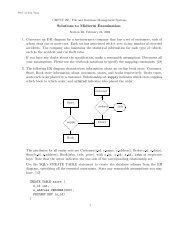CMPUT 340—Introduction to Numerical Methods - Department of ...
CMPUT 340—Introduction to Numerical Methods - Department of ...
CMPUT 340—Introduction to Numerical Methods - Department of ...
You also want an ePaper? Increase the reach of your titles
YUMPU automatically turns print PDFs into web optimized ePapers that Google loves.
Computer Problem 9.7. (Page 419)<br />
An important problem in classical mechanics is <strong>to</strong> determine the motion <strong>of</strong> two bodies under<br />
mutual gravitational attraction. Suppose that a body <strong>of</strong> mass m is orbiting a second body<br />
<strong>of</strong> much larger mass M, such as the earth orbiting the sun. From New<strong>to</strong>n’s laws <strong>of</strong> motion<br />
and gravitation, the orbital trajec<strong>to</strong>ry (x(t), y(t)) is described by the system <strong>of</strong> second-order<br />
ODEs<br />
x ′′ = −GMx/r 3 ,<br />
y ′′ = −GMy/r 3 ,<br />
where G is the gravitational constant and r = (x 2 + y 2 ) 1/2 is the distance <strong>of</strong> the orbiting<br />
body from the center <strong>of</strong> mass <strong>of</strong> the two bodies. For this exercise, we choose units such that<br />
GM = 1.<br />
(a) Use a library routine <strong>to</strong> solve this system <strong>of</strong> ODEs with the initial conditions<br />
x(0) = 1 − e, y(0) = 0,<br />
x ′ (0) = 0,<br />
( ) 1 + e 1/2<br />
y ′ (0) =<br />
,<br />
1 − e<br />
where e is the eccentricity <strong>of</strong> the resulting elliptical orbit, which has period 2π. Try<br />
the values e = 0 (which should give a circular orbit), e = 0.5, and e = 0.9. For each<br />
case, solve the ODE for at least one period and obtain output at enough intermediate<br />
points <strong>to</strong> draw a smooth plot <strong>of</strong> the orbital trajec<strong>to</strong>ry. Make separate plots <strong>of</strong> x versus<br />
t, y versus t, and y versus x. Experiment with different error <strong>to</strong>lerances <strong>to</strong> see how<br />
they affect the cost <strong>of</strong> the integration and how close the orbit comes <strong>to</strong> being closed.<br />
If you trace the trajec<strong>to</strong>ry through several periods, does the orbit tend <strong>to</strong> wander or<br />
remain steady<br />
(b) Check your numerical solutions in part a <strong>to</strong> see how well they conserve the following<br />
quantities, which should remain constant:<br />
Conservation <strong>of</strong> energy:<br />
(x ′ ) 2 + (y ′ ) 2<br />
2<br />
Conservation <strong>of</strong> angular momentum:<br />
− 1 r ,<br />
xy ′ − yx ′ .<br />
(Note: you can use any <strong>of</strong> the ODE solvers in “help funfun” that you wish <strong>to</strong> solve this<br />
question, but please document your choice.)<br />
4




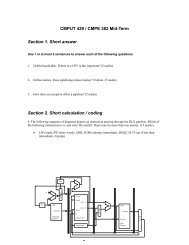

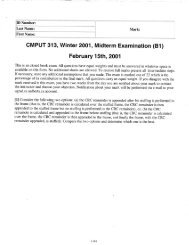
![CMPUT 313 Final Exam [Harms] April 26, 2000 g L (Ilosed Book](https://img.yumpu.com/45617471/1/190x245/cmput-313-final-exam-harms-april-26-2000-g-l-ilosed-book.jpg?quality=85)
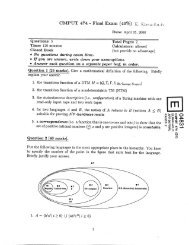
![CMPUT 379 Midterm Exam [Harms]](https://img.yumpu.com/44750568/1/190x245/cmput-379-midterm-exam-harms.jpg?quality=85)



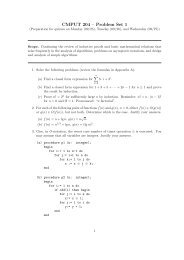

![CMPUT 272 Midterm [B2 -- Harms]](https://img.yumpu.com/36401258/1/190x245/cmput-272-midterm-b2-harms.jpg?quality=85)
